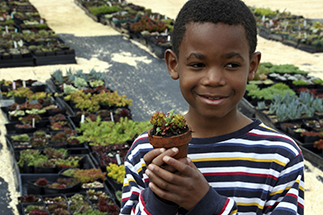Easy-to-grow garden plants

A child can be given responsibility for a particular plant in the garden. Make sure that the plant chosen is not a particularly temperamental or fragile plant. Geraniums (pelargoniums) are almost indestructible. Clumping plants like agapanthus (there are some wonderful, smaller growing cultivars) and liriope (monkey grass or lilyturf), lavender, cuphea (false heather, Mexican heather, Hawaiian heather or elfin herb), abelia and citrus, as long as they are given the most basic of care, are hard to kill.
Easy-to-grow seeds
Growing plants from seed gives a child a chance to understand the very basics of nature. To achieve success, a child will need some guidance. Here are a few tips for successful seed-raising:
- Read the packet. If it says sow in seed trays or pots, then do so.
- Sow at the right time of year. Germination is very temperature dependent.
- Sow into seed-raising mix.
- Keep seed trays in bright light, but out of direct sunlight.
- Keep seeds moist. Water gently with a watering-can or a very soft water-breaker.
Some seeds are easy for beginners as long as you follow basic instructions on the packet.
Easy flowers from seeds
Flowers that children will like to grow include nasturtiums, sweet peas, sunflowers, Mexican sunflowers (Tithonia), marigolds, cosmos, rudbeckia, pansies and violas. Always sow in the right season. Avoid plants with tiny seeds, such as petunias and lobelias. These can be difficult for the inexperienced seed grower.
Mixed packets of flower seeds (some of them especially labelled for children) can be scattered onto flower beds. Keep moist and something is bound to come up.
Gardens kids can eat
Most children like to have a productive garden but it is essential that the fruits and vegetables grown by children are things they are likely to eat. For example, radishes give satisfyingly fast results, but very few children enjoy eating them. Some veggies that are popular with kids are sweet corn, cherry tomatoes, beans straight off the plant (not cooked) and snow peas.
Easy-to-grow fruits include strawberries (which can even be grown in a hanging basket), citrus trees of most kinds, especially naartjies, grenadillas, and raspberries in colder climates.
Productive plants need a sunny position, compost-enriched soil, and plenty of water and fertiliser.
Container gardening
Gardening in pots or containers is a good way to kick-start a child’s interest in gardening. The basics for success are:
- Don’t have too small a container – it will dry out too quickly and need to be watered too often.
- Use a good quality potting mix. Ask at your nursery for the best one and check that it is non-toxic.
- Water with a water-breaker (not a nozzle) attached to the end of a hose.
- Don’t allow the base of the pot to sit in water.
- Potting mixes need more fertiliser than soil. Feed regularly during the growing season with a soluble plant food, or controlled release pellets. Ask at your nearby nursery for a potting soil that doesn’t need fertiliser.
- Wash hands after handling potting soil/ soil.

Secret gardens
Children love parts of the garden that are a bit secretive and enclosed and where they can feel alone but secure.
One of the most famous twentieth-century children’s stories, The Secret Garden by Frances Hodgson Burnett, surely owes much of its enduring popularity to the fact that every child fantasises about having a secret outdoor place to escape to.
If your garden can be designed with some slightly hidden or separate sections, it will have a special appeal for children.
For more information see Gardening with kids or Parenting.
Visit these websites to find out more:

